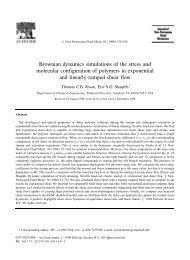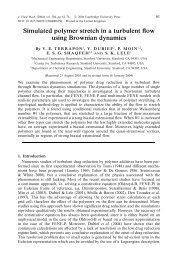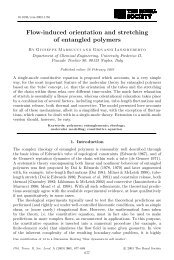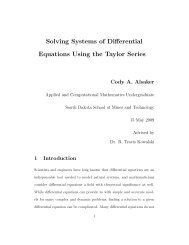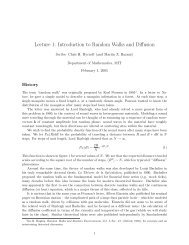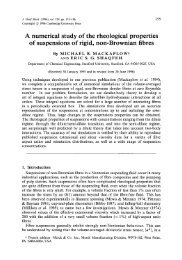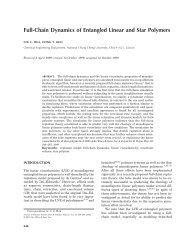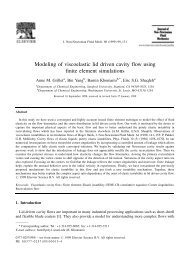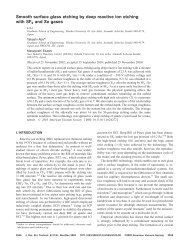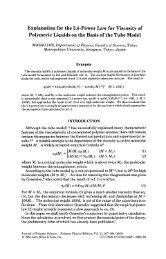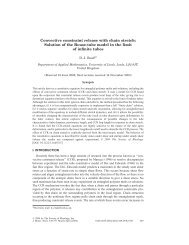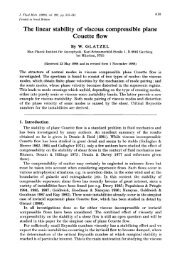Molecular modelling of entangled polymer fluids under flow The ...
Molecular modelling of entangled polymer fluids under flow The ...
Molecular modelling of entangled polymer fluids under flow The ...
You also want an ePaper? Increase the reach of your titles
YUMPU automatically turns print PDFs into web optimized ePapers that Google loves.
2.3. DOI-EDWARDS MODEL OF ENTANGLED POLYMERS 27<br />
Cloizeaux (1990), Milner and McLeish (1998b)], however each <strong>of</strong> these approaches is<br />
either an incomplete solution or is based around uncontrolled assumptions. Recently<br />
Likhtman and McLeish (2002) obtained a solution via a combined stochastic and analytic<br />
method. In this approach analytic arguments are used to derive expressions for<br />
the relaxation but with unknown coefficients. Numerical values for these coefficients<br />
are found by fitting the results to stochastic simulations <strong>of</strong> the first passage problem <strong>of</strong><br />
a full Rouse chain in a tube. If thermal constraint release (see section 2.4) is included as<br />
well, this method produces good agreement with the viscosity measurements <strong>of</strong> Colby<br />
et al. (1987), which cover a particularly wide range <strong>of</strong> molecular weights spanning either<br />
side <strong>of</strong> M c . This theory has also been shown to produce excellent predictions for the<br />
shape <strong>of</strong> G ′ (ω) and G ′′ (ω) <strong>of</strong> monodisperse linear <strong>polymer</strong> melts.<br />
2.3.3 Non-linear rheology<br />
<strong>The</strong> DE model can be generalised to non-linear <strong>flow</strong>s. This has been achieved, with some<br />
success, for a range <strong>of</strong> <strong>flow</strong> situations. For example continuous forward deformations<br />
can be modelled by assuming the deformation rate to be small with respect to the chain<br />
Rouse time. This still allows a window <strong>of</strong> non-linear rates since the reptation time and<br />
the Rouse time are fairly well separated in an <strong>entangled</strong> melt (τ d /τ R = 3Z). In this<br />
case the chain retraction can be assumed to be instantaneous. <strong>The</strong> model thus consists<br />
<strong>of</strong> three processes: affine deformation <strong>of</strong> the tube due to convection, instantaneous<br />
retraction along the tube and reptation, as described above. This model has been<br />
solved using a variety <strong>of</strong> different pre-averaging approximations. <strong>The</strong> most widely used<br />
<strong>of</strong> these is the independent alignment approximation (IAA) which disregards the fact<br />
that, as the chain retractions, orientation information is passed from one tube segment<br />
to the next. This considerably simplifies the solution <strong>of</strong> the model. <strong>The</strong> model predicts<br />
a number <strong>of</strong> qualitative features that are in agreement with experimental data. <strong>The</strong>se<br />
were considerable improvements over preceding models. In extension the model predicts<br />
extension thinning in steady state, in agreement with data on monodisperse samples.<br />
In non-linear shear the model predicts a transient overshoot in shear stress, but not<br />
in normal stress, and strong shear thinning at high shear rates. Qualitatively, all <strong>of</strong><br />
these features are observed experimentally. <strong>The</strong> issue <strong>of</strong> shear thinning is particularly<br />
significant. <strong>The</strong> Rouse model, outlined in section 2.2.4, has a constant shear viscosity,<br />
and hence the shear thinning phenomenon can be attributed to the influence <strong>of</strong> chain<br />
entanglements. However, the DE model predicts too much shear thinning which itself<br />
can be problematic (see section 2.4).<br />
An even greater degree <strong>of</strong> success was achieved in the prediction <strong>of</strong> stress relaxation<br />
after a large step shear deformation. <strong>The</strong> model assumes a perfectly affine deformation<br />
followed by two relaxation processes. <strong>The</strong> chain relaxes its primitive path length back



